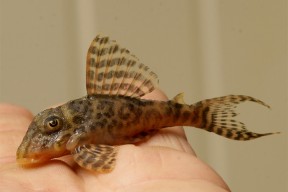Hypancistrus sp.
L066, King Tiger Plec
Etymology
Hypancistrus: from the Greek ὑπό (hypó), meaning ‘below, beneath, under’, and the generic name Ancistrus, in reference to the reduced dentition compared with the latter.
Classification
Order: Siluriformes Family: Doradidae
Distribution
Collected from the rio Xingu downstream and in the vicinity of Belo Monte, Pará state, northern Brazil.
The majority of its natural habitat is likely to be severely degraded in the near future due to ongoing construction of the Belo Monte dam.
Habitat
Typically inhabits turbulent stretches of whitewater rapids with rocky substrates.
Maximum Standard Length
120 – 140 mm.
Aquarium SizeTop ↑
An aquarium with base dimensions of 120 ∗ 45 cm or equivalent should be the smallest considered.
Maintenance
Not difficult to maintain under the correct conditions; we strongly recommend keeping it in a tank designed to simulate a flowing stream with a substrate of variably-sized rocks, sand, fine gravel, and some water-worn boulders.
This can be further furnished with driftwood branches, terracotta pipes, plant pots, etc., arranged to form a network of nooks, crannies, and shaded spots, thus providing broken lines of sight.
Like many fishes that naturally inhabit running water it’s intolerant to accumulation of organic pollutants and requires spotless water in order to thrive. Weekly water changes of 30-50% tank volume should also be considered routine.
Though torrent-like conditions are unnecessary it does best if there is a high proportion of dissolved oxygen and some water movement in the tank meaning power filter(s), additional powerhead(s), or airstone(s) should be employed as necessary.
Water Conditions
Temperature: 26 – 30 °C
pH: 5.0 – 7.0
Hardness: 36 – 268 ppm
Diet
Except when juvenile, these prefer a meaty diet. This can consist of live and frozen foods such as bloodworm, chopped mussel and prawn and sinking dried foods. Algae and other vegetable matter is not taken, but the occasional slice of cucumber or courgette might be nibbled at.
Behaviour and CompatibilityTop ↑
A generally peaceful species which can be maintained in a well-chosen community alongside other quiet fishes.
It should not be maintained alongside other Hypancistrus spp. in order to prevent hybridisation.
Sexual Dimorphism
Males are more slender and less stocky than females, a difference which is easily observed when the fish are viewed from above.
Odontode development is often comparable in both sexes although some older males exhibit more extensive growth on the pectoral fins.
Reproduction
Cave-spawner with the male responsible for brood care. Has been bred regularly in aquaria.
NotesTop ↑
This unidentified species is also traded as ‘network pleco’ and ‘scribbled pleco’ and has a highly variable colour pattern.
It’s regularly confused with similar-looking relatives such as L333 and L400, but differs from the former in possessing a much finer pattern of pale markings on the body and the latter by its less elongate, squatter body shape.
The genus Hypancistrus is diagnosed from all other loricariids by a wide separation between the metapterygoid and lateral ethmoid, presence of a sharply angled adductor palatini crest of the hyomandibula, and no lateral wall in the metapterygoid channel.
More useful for aquarists is the fact that in Hypancistrus the dentary teeth are about twice as long as the premaxillary teeth (vs. dentary and premaxillary teeth of approximately equal length).
The genus is otherwise remarkable for the fact that the majority of species have not yet been described to science although many are well known in the aquarium hobby. As of January 2016, there are eight described species in the genus: the type species H. zebra Isbrücker and Nijssen 1991, H. inspector Armbruster 2002, H. contradens Armbruster et al. 2007, H.debiliterra Armbruster et al. 2007, H. furunculus Armbruster et al. 2007, H. lunaorum Armbruster et al. 2007, H. margaritatus Tan & Armbruster 2016 and H. phantasma Tan & Armbruster 2016.
References
- Armbruster, J. W., 2002 - Copeia 2002(1): 86-92
Hypancistrus inspector: a new species of suckermouth armored catfish (Loricariidae: Ancistrinae). - Armbruster, J. W., N. K. Lujan and D. C. Taphorn, 2007 - Copeia 2007(1): 62-79
Four new Hypancistrus (Siluriformes: Loricariidae) from Amazonas, Venezuela. - Stawikowski, R., A. Werner and I. Seidel, 2004 - DATZ: 1-132
DATZ Special: L-Numbers. - Tan, M. and J. Armbruster, 2016 - ZooKeys 552: 123-135
Two new species of spotted Hypancistrus from the Rio Negro drainage (Loricariidae, Hypostominae)






